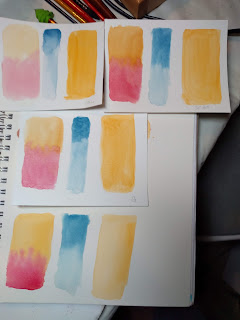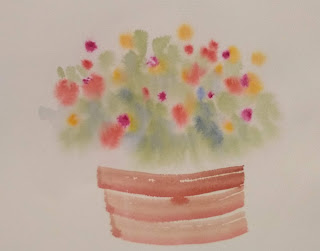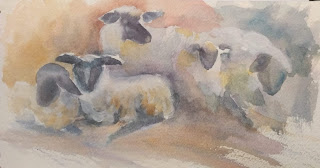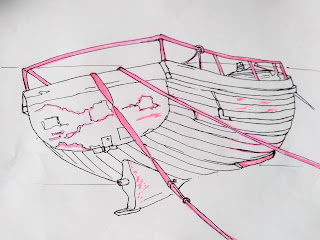COMPARING PAPERS:
The focus on the next six weeks is going to be comparing surfaces and papers for watercolors.
Today I wanted to emphasize why I ask for quality watercolor paper. We compared three brands you can get at any hobby store inexpensively: Canson XL; Grumbacher; and Strathmore 300, with Arches or another paper 100% cotton. The first three are not cotton, but wood pulp or celulose.
When I'm teaching a class, I want students to have the best experience possible, and that starts with decent paper. Think about learning and instrument, such as a piano. You don't need to have the most expensive piano to learn...but it does have to be in tune. Trying to learn on poor paper is like trying to learn music on a poorly tuned instrument.
I want the paper they use to do it all. So here are my judging criteria:
1. Is it 100% cotton and acid free?
2. Does it accept washes without streaking?
3. When I use wet-on-wet technique (wetting paper first, then adding paint), does the color spread evenly and is the color vibrant?
4. What about lifting? (lifting is using a firm brush with clean water to lift out or wipe away (erase or soften) the paint. I want it to lift some, but not too easily. If it lifts too easily, then glazng could be an issue.
5. Does it glaze evenly? (adding layers of color over dry layers)
6. Does it accept tape without tearing? Does it accept masking fluid without tearing when I take it off? This will affect what techniques I use to preserve the whites of the paper.
7. Does it stay relatively flat while I'm painting? (not curling too easily)
8. Can I paint on both sides of the paper?
One of the reasons I ask people to get Arches 140 lb cold press is because Arches doesn't make an inferior or "student grade" paper. You won't go to the store, ask for Arches, and be confused by different grades of paper, some of lesser quality, all with the same brand. But in the last few months Arches has been hard to get or quite expensive. So I've been using Kilimanjaro (Cheap Joe's brand), Baohong (a Chinese paper in a block), or Fabriano Artistico.
There are other good brands, and I hope to explore some of those later on. European artists frequently use Saunders Waterford because that is more widely available overseas.
PRACTIVE FOR TODAY
I gave each person a sample of Canson XL, Strathmore 300, and Grumbacher. We tried the same techniques on those papers, then did the same on a piece of good paper to compare.

Top to bottom, the papers are Canson XL,Strathmore 300, Grumbacher, and Kilimanjaro on the bottom. One the left of each is a wet into wet wash of yellow and red. The colors on the cheaper papers are less vibrant and splotchier. The center blue line of color is Mayan Blue, fading the color with water each time. The large patch of yellow on the right will be used to see how well each one glazes.
 You can see how I've glazed the yellow strip with blue, red, green, and yellow to see how well each one performs. The three top ones are a bit blotchy with only one glaze. Future glazes will be worse.
You can see how I've glazed the yellow strip with blue, red, green, and yellow to see how well each one performs. The three top ones are a bit blotchy with only one glaze. Future glazes will be worse.
Another test, on the right, is how well does it take tape and masking fluid. You apply both on dry paper; dry the fluid completely; wash paint over it. The paint must be absolutely dry before removing tape or masking fluid. If you use a hair dryer, be sure to dry on COOL so you don't glue the tape or fluid to the paper.
LIFTING: Try using a firm brush to lift paint off. Dip the brush in clean water and drag it through the paint. On less expensive papers, the paint might lift completely off. Nice, if you want to lift completely; not so nice if you plan to put more color over it.
SO LET'S PLAY
Try making a multicolor wash as discussed in class. (Use a larger brush to wet the paper and then to apply the paint) I started with blue, added a magenta (pinkish red) then a purple. When you are blending one color into another it is called a variegated. Try to make as few streaks as possible.
(three basic types of washes: flat--all one shade of one color; graded--all one color going from dark to light---variegated, blending one color into the next).
Let the wash dry completely. Drag lines of color, like grasses or weeds, over the wash. Use different colors than you used for the wash. Can you see how the color underneath pops through the grasses on top? That's glazing.
This is done the same way, only my wash is done on a diagonal. It sort of looks like a tropical palm in a sunset.
PLAY #2
Using clean water, make a rainbow shape over the paper. Then drop bits of color all over. Drop some next to each other (blue and violet; or yellow and red) to blend. Then drop some greens and blues for foliage.
With a flat brush dipped in burnt sienna make three horizontal stripes one beneath another on dry paper. The "tooth" of the paper creates a dry brush effect.

You can finish this however you like. Below is one done in the same style:
I just added details and spattered.


















